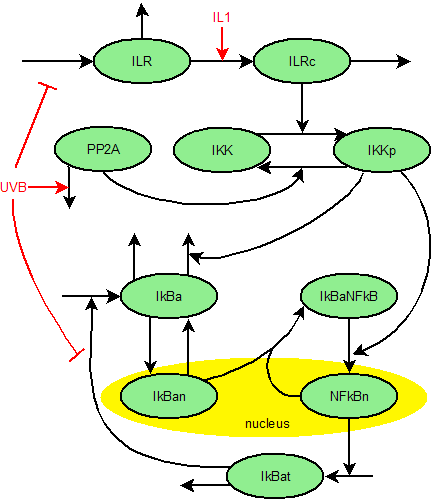| Project Overview |
|||
|
Programmed cell death (apoptosis) is an important cellular protection mechanism for selective elimination of potentially degenerated cells. The transcription factor NF-κB typically inhibits apoptosis by inducing the expression of antiapoptotic proteins. Constitutively active NF-κB in tumor cells designates signaling pathways of NF-κB activation as interesting targets for the development of new anticancer agents. NF-κB itself is subject to a strict negative feedback regulation by NF-κB dependent resynthesis of the NF-κB inhibitor IκBα. The cytokine interleukin-1ß (IL-1) typically acts in an antiapoptotic way by inducing NF-κB activation. Interestingly, apoptosis induced by ultraviolet-B radiation (UVB) is not inhibited but significantly enhanced upon co-stimulation with IL-1. This effect was shown to be related to NF-κB dependent expression of TNFα, thus suggesting that NF-κB can also act as a promoter of apoptosis (Pöppelmann et al., 2005). The proapoptotic effect of NF-κB coincides with a sustained NF-κB activity due to the persistent absence of its inhibitor IκBα. The aim of this project is to understand the reasons for the persistent absence of IκBα following IL-1 + UVB stimulation. One reason was experimentally shown to be the sustained activity of the IκBα kinase IKKß, due to UVB induced deactivation of the IKKß phosphatase PP2A (Barisic et al., 2008). To investigate this mechanisms in more detail, a model for IL-1 induced NF-κB activation and regulation was generated by adapting and reducing the existing model of Lipniacki et al. (2004). The model reduction allows the investigation of IKKß phosphorylation independent of the downstream processes. It is shown that PP2A is constitutively active. Its UVB-induced deactivation is likely to be mediated by other molecules (Witt et al., 2009). For low IL-1 stimulations, IKKß phosphorylation is delayed: modeling predicts the existence of an autoactivation process in the signaling cascade, possibly TRAF6 auto-ubiquitination (Witt et al., 2011). A model of the complete pathway is obtained by coupling the IKKß phosphorylation module to a model describing the downstream processes. The model can quantitatively reproduce and independently predict a variety of different experimental data. Comparison to model variants shows that the processes leading to NF-κB activation are shown to be more complex than previously thought. They involve a cross-talk of UVB-induced translational inhibition and PP2Ac deactivation. The contribution of each of the processes is determined by in silico knock-outs. It largely varies depending on the stimulation and cellular setting: upon IL-1+UVB stimulation, PP2A deactivation is predominantly responsible for lack of IκB recurrence. However, both processes are required to cause IκB degradation following UVB stimulation alone in the investigated cell line. In other cell lines, translational inhibition alone may be sufficient to cause IκBα degradation upon UVB stimulation (Witt et al., 2012).
|
| Partners |
|
Institute for Cell Biology and Immunology (IZI), Univeristy of Stuttgart, Germany
|
| Publications | |||
|
Journal Papers
Conference Papers
|
| Funding | ||||
|
The project was funded by the DFG.
|
|
| Contact | |||
|
Julia Rex
|


